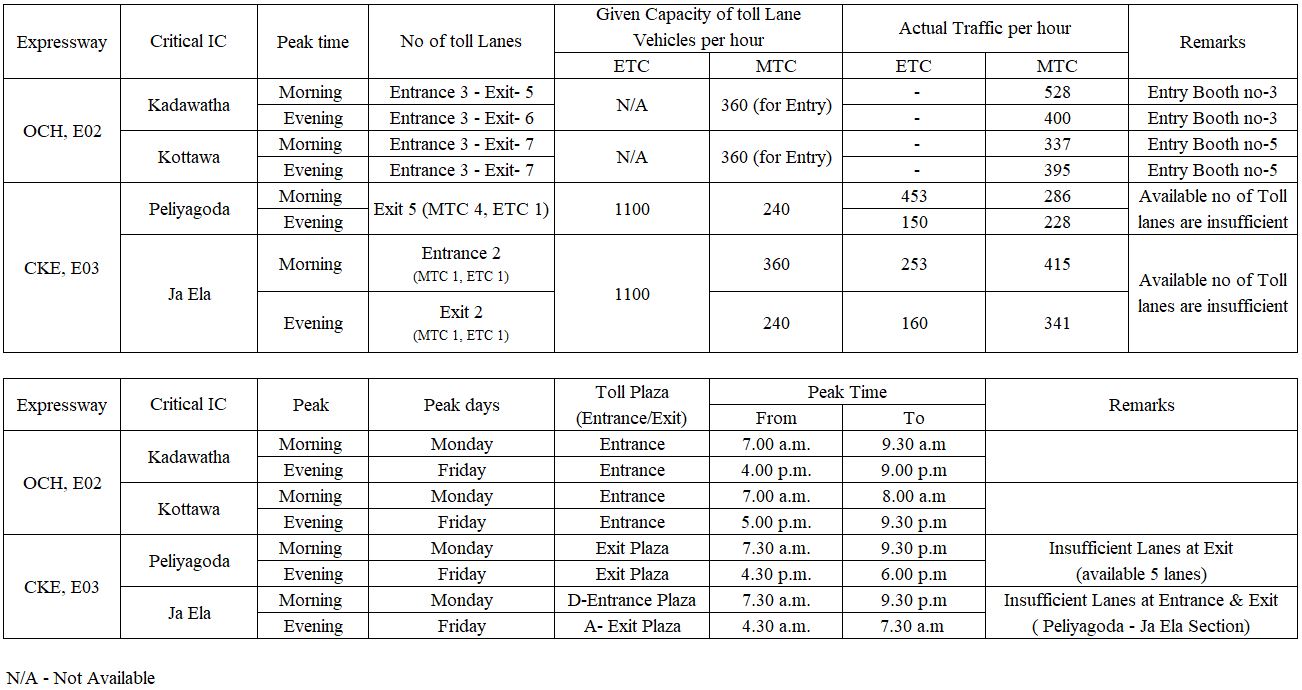 |
Expressway Operation Maintenance And Management Division Road Development Authority - Sri Lanka |
 |
 |
Is it required to introduce congestion charges for Sri Lankan Expressways?
The undue traffic congestions that have been taken place along Main & Secondary Highways, Sub urban road networks experience severe congestion during peak hours (morning, afternoon & evening). Today the congestion is causing unbearable delays, excessive emissions of gasses along with increasing of user costs.
Current status has revealed that most of vehicles which are normally utilizing the national highways during peak hours have selected the expressway network to save their journey time.
Tolling systems currently available in the expressway network in operation are as follows.
| E-01 : | Southern Expressway : | Manual Toll collection (MTC) |
| E-02 : | Outer circular Highway : | Manual Toll collection (MTC) |
| E-03 : | Colombo-Katunayake Expressway : | MTC & Electronic Toll Collection (ETC) |
All these expressways have been designed & built with dual carriageways on both directions with inner and outer shoulders having a lane capacity of 2800 vehicles per hour / lane. As per the current status it is observed that sectional traffic flow between Interchanges (ICs) are far below the capacity, as such expressways are functioning at high level of service, however increase in traffic flow is observed during the months of April, August & December due to seasonal traffic.
However Traffic congestions are reported at exit booths of following interchanges (ICs) during peak hours. These ICs are located at outer skirt of the Metropolitan area, connecting Trunk roads radiating from the Colombo city center.
| Expressway | Interchange (I/C) |
| (i). Outer circular Highway | Kadawatha , Kaduwela , Kothalawala , Athurugiriya & Kottawa |
| (ii). Colombo-Katunayake Expressway | Paliyagoda & Ja-Ela |
The above issues have been taken place due to several factors such as limited land area, implementation of limited toll booths during planning & construction stages and that has been drastically changed due to subsequent surrounding developments during operations.
As at today it could be observed that queuing are taking place on expressways at exit booths particularly during peak hours.
In our understanding that the expressway network have been introduced to offer a high-speed travel environment with a safe & comfort journey for road users. Hence the users will tend to utilize the expressway network to get the aforementioned benefits that are not available at alternative road networks.
Therefore introduction of congestion pricing would deprive the privileges of the public users. Following options are available to relief the congestion at the exit booths improving infrastructures & application of new technology.
Adverse impacts of charging hire toll fees during peak hours.
Reduce the daily Traffic & toll income due to demotivation of daily commuters (Daily commuters use expressways during the peak hours by paying toll fee to avoid the congestion at normal roads). If the Government introduce congestion charges, they should be paid considerable amount of additional money per month as congestion price.
Introducing of a fixed rate (Rs. 100.00) doesn't have any rationally, instead it would be desirable to charge based on the travel distance and the vehicle categories.
- For Toll Fee Rs. 200.00 - increment is 50%
- For Toll Fee Rs. 300.00 - increment is 33%
- For Toll Fee e Rs 450.00 - increment is 22%
- Additional vehicle traffic will be developed on local roads due to diversion of Expressway users during peak hours.
Based on this, the price change significantly over the category 01 (All cars, All Jeep, vans up to 6 seat, Saloon vehicles) vehicles as well as small distance travelled vehicles. Normally, more than 90% of vehicles are category 01 (All cars, All Jeep, vans up to 6 seat, Saloon vehicles) vehicles in all Expressways and this will be adversely affected for toll revenue.
Conclusive remarks
-
To formulate evidence based toll policy directives to suit our context.
-
Priority should be given for early implementation of Electronic Toll Collection System (ETC) in addition to Manual System with appropriate Advance Traffic information system (ITS Intelligent Transportation System)
